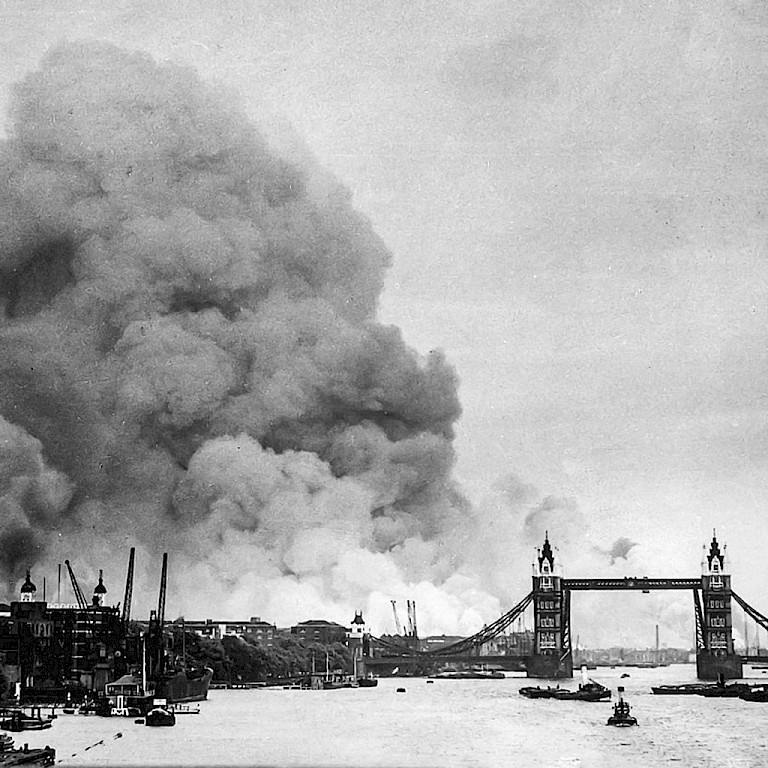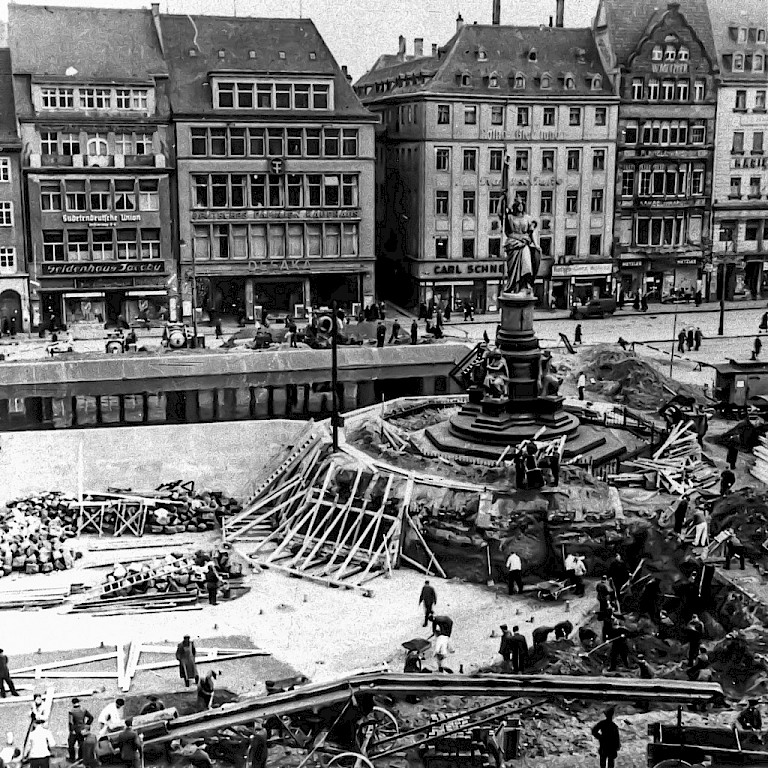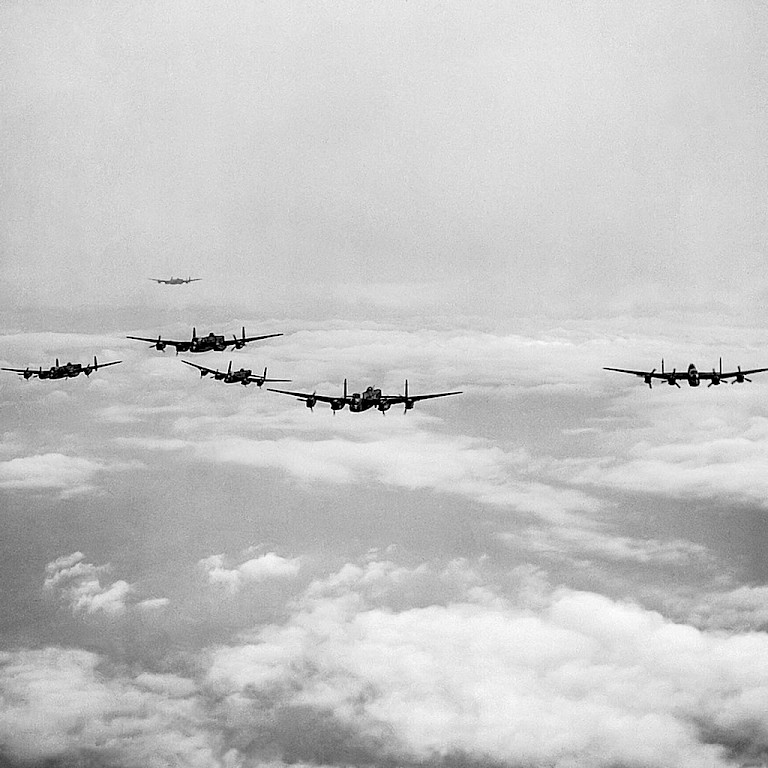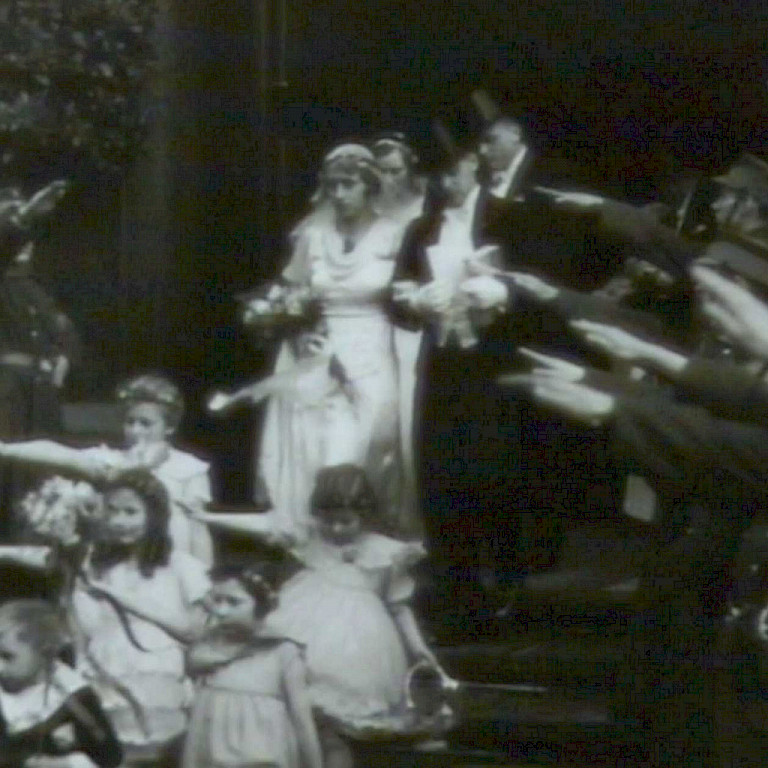
Bombardierung Londons am 7. September 1940
Foto: wikipedia, gemeinfrei

Dresdner Altmarkt mit im Bau befindlichen Löschwasserbecken. 1943
Foto: Museen der Stadt Dresden

Bomber der britischen Royal Air Force im Zweiten Weltkrieg
Foto: Wikimedia, gemeinfrei

Massentrauung in der Dresdner Frauenkirche. 1938. Film Still
© Filmarchiv Hirsch-Film Dresden
Filmausschnitt aus »Dresden blasted«. 1945.
© Filmarchiv Hirsch-Film Dresden
08 THE BOMBARDMENT OF DRESDEN
The air force, commanded by Hermann Göring, played a special role in German warfare. Its main task was to support the ground forces, but as the example of Wielun showed, they resembled terrorist attacks more and more.
In 1940, Adolf Hitler planned the invasion of England. After the battles against Poland and France, the air forces were preparing to take out the British Royal Air Force. When a landing of German troops no longer seemed possible, the German air force, concentrated its attacks on industrial areas and urban targets to force England to surrender.
On the 7th of September 1940, the German bombers attacked London for the first time, followed two months later by a devastating large-scale attack on Coventry. Other industrial cities such as Manchester, Liverpool, Birmingham, and Sheffield were also badly hit by German air raids. The destruction of cultural sites and residential areas was always accepted with approval. By June 1941, some 43,000 people had been killed.
In May 1940, Britain struck back. Immediately after the Wehrmacht invaded the Benelux countries, Monchengladbach was attacked.
In the years that followed, the Royal Air Force Bomber Command began bombing densely populated city centres and residential areas throughout Germany. The aim of these large-scale attacks was to weaken the German populations morale and to turn against Hitler.
From the British side, this procedure, which is still highly controversial today, was called “moral or strategic bombing”.
In February 1942, area or carpet bombing was declared the official air war strategy. The industrial metropolis of Essen was hit first.
It was followed by countless other attacks on major cities such as Cologne, Hamburg, and Frankfurt. Dresden, then the largest city in Saxony was spared for a long time.
The feeling of perceived safety was one of the reasons that the local authorities made few provisions for emergencies. Even after Leipzig was heavily bombed in December 1943, the measures to protect Dresden’s population remained totally inadequate. There was a lack of air raid shelters throughout the city. The fire water basins on the Old Market Place were no longer symbolic politics.
For the Allies, Dresden was increasingly becoming a focus of attention. After all, the intact large city on the Elbe as an armament’s location, traffic junction and strategically important garrison city near to the front was decisive for the continuation of the war.
In October 1944, the 8th US Air Force bombed the marshalling yard Dresden Friedrichstadt and its surroundings. Three months later, a much stronger air raid on Friedrichstadt station followed. About 600 people died in the attacks with many survivors homeless.
Thus, the war had finally arrived in Dresden. Dresden was the target of a massive air strike in early 1945 because of military strategic and political reasons.
In the night of the 13th to 14th of February 1945, the Royal Air Force launched a major attack on Dresden. Over 700 Lancaster bombers were involved in the operation. The first two waves of the attack arrived shortly after 10 o’clock in the evening.
The planes laid a carpet of demolition bombs, aerial mines and incendiary bombs over the old town and neighbouring districts. Later in the night, a second, even bigger attack followed.
Through this attack, the pilots ignited a firestorm that devastated the historic city centre. The glow of the burning city could be seen from a long way off. Thousands of people were killed on this night in February.
The city was not granted a break. At noon on the 14th of February, the 8th US Air Force attacked again. Their actual target was the station in Dresden-Friedrichstadt, but most of the bombs hit its surroundings.
After the three attacks, the city centre laid in ruins. Miraculously, the Church of Our Lady still rose amidst the ruins – until on the 15th of February it burnt out and collapsed. A short time later, American planes appeared again over the city and dropped demolition bombs. It was the fourth bombing in about 38 hours.
As the motif for his 360-degree panometer, Yadegar Asisi chose the moment when, after four heavy air raids on Dresden’s city centre, the catastrophic extent of the destruction became visible.